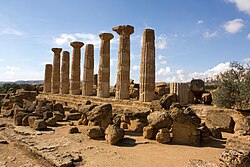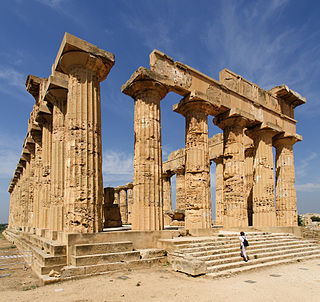
Selinunte was a rich and extensive ancient Greek city of Magna Graecia on the south-western coast of Sicily in Italy. It was situated between the valleys of the Cottone and Modione rivers. It now lies in the comune of Castelvetrano, between the frazioni of Triscina di Selinunte in the west and Marinella di Selinunte in the east.
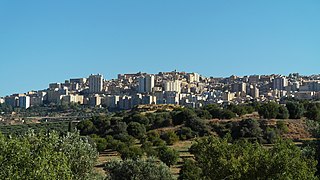
Agrigento is a city on the southern coast of Sicily, Italy and capital of the province of Agrigento.

Magna Graecia is a term that was used for the Greek-speaking areas of Southern Italy, in the present-day Italian regions of Calabria, Apulia, Basilicata, Campania and Sicily; these regions were extensively populated by Greek settlers starting from the 8th century BC.

Ancient Greek architecture came from the Greeks, or Hellenes, whose culture flourished on the Greek mainland, the Peloponnese, the Aegean Islands, and in colonies in Anatolia and Italy for a period from about 900 BC until the 1st century AD, with the earliest remaining architectural works dating from around 600 BC.

The Doric order is one of the three orders of ancient Greek and later Roman architecture; the other two canonical orders were the Ionic and the Corinthian. The Doric is most easily recognized by the simple circular capitals at the top of the columns. Originating in the western Doric region of Greece, it is the earliest and, in its essence, the simplest of the orders, though still with complex details in the entablature above.

Greek temples were structures built to house deity statues within Greek sanctuaries in ancient Greek religion. The temple interiors did not serve as meeting places, since the sacrifices and rituals dedicated to the deity took place outside them, within the wider precinct of the sanctuary, which might be large. Temples were frequently used to store votive offerings. They are the most important and most widespread surviving building type in Greek architecture. In the Hellenistic kingdoms of Southwest Asia and of North Africa, buildings erected to fulfill the functions of a temple often continued to follow the local traditions. Even where a Greek influence is visible, such structures are not normally considered as Greek temples. This applies, for example, to the Graeco-Parthian and Bactrian temples, or to the Ptolemaic examples, which follow Egyptian tradition. Most Greek temples were oriented astronomically.

The Forum Holitorium or Olitorium is an archaeological area of Rome, Italy, on the slopes of the Capitoline Hill. It was located outside the Carmental Gate in the Campus Martius, crowded between the cattle market and buildings located in the Circus Flaminius.

The province of Agrigento is a province in the autonomous island region of Sicily, Italy, situated on its south-western coast. Following the suppression of the Sicilian provinces, it was replaced in 2015 by the Free Municipal Consortium of Agrigento. It has an area of 3,041.90 square kilometres (1,174.48 sq mi), and a total population of 474,493. There are 43 comuni in the province.

The Temple of Aphaia or Afea is an Ancient Greek temple located within a sanctuary complex dedicated to the goddess Aphaia on the island of Aegina, which lies in the Saronic Gulf. Formerly known as the Temple of Jupiter Panhellenius, the Doric temple is now recognized as having been dedicated to the mother-goddess Aphaia. It was a favourite of Neoclassical and Romantic artists such as J. M. W. Turner. It stands on a c. 160 m peak on the eastern side of the island approximately 13 km east by road from the main port.

The Temple of Olympian Zeus in Agrigento, Sicily was the largest Doric temple ever constructed, although it was never completed and now lies in ruins. It stands in the Valle dei Templi with a number of other major Greek temples.
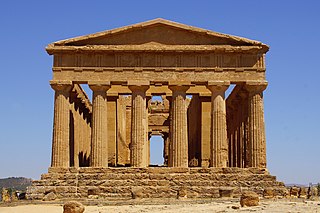
The Valle dei Templi, or Valley of the Temples, is an archaeological site in Agrigento, Sicily. It is one of the most outstanding examples of ancient Greek art and architecture of Magna Graecia, and is one of the main attractions of Sicily. The term "valley" is a misnomer, the site being located on a ridge outside the town of Agrigento.
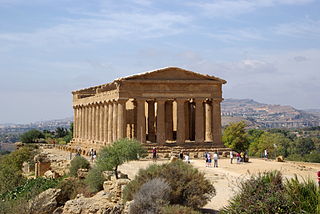
The Temple of Concordia is an ancient Greek temple of Magna Graecia in the Valle dei Templi in Agrigento on the south coast of Sicily, Italy. It is the largest and best-preserved Doric temple in Sicily and one of the best-preserved Greek temples in general, especially of the Doric order. It is located a kilometer east to the Temple of Heracles.

The Temple of Apollo is one of the most important ancient Greek monuments of Magna Graecia on Ortygia, in front of the Piazza Pancali in Syracuse, Sicily, Italy.
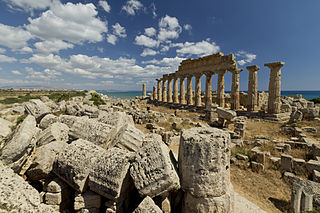
Temple C at Selinus (Sicily), is a Greek temple of Magna Graecia in the Doric style. It was one of the most ancient of the temples at Selinus, having probably been built on the acropolis a little after the middle of the sixth century BC, although its dating is controversial. The temple was the object of archaeological research in the nineteenth century and beginning of the twentieth century and later the remains of a long stretch of the northern colonnade received anastylosis in 1929. After a twelve-year-long restoration, in 2011 the colonnade was freed from scaffolding and made properly visible once more.
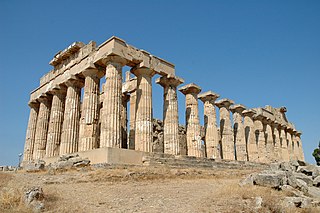
Temple E at Selinus in Sicily is a Greek temple of Magna Graecia of the Doric order. It is found on the hill to the east of the city's acropolis. Temple E is also known as the Temple of Hera because an inscription found on a votive stela indicates that it was dedicated to Hera; however, some scholars argue that it must have been dedicated to Aphrodite on the basis of structural parallels. It was built towards the middle of the fifth century BC on top of the foundations of a more ancient building. It is the best conserved of the temples of Selinus but its present appearance is the result of anastylosis performed—controversially—in 1959, by the Italian archaeologist Jole Bovio Marconi.

The Temple of Athena is a hexastyle peripteral Doric temple built in Syracuse, Magna Graecia, in the 5th century BC by the tyrant Gelo after his victory over the Carthaginians at the Battle of Himera. The temple was preceded by a cult site which dated back to the 8th century BC, with an altar discovered in excavation at the beginning of the twentieth century, and by an earlier temple from the middle of the sixth century BC.

The Temple of Sangri is a Late Archaic Greek temple on the Cycladic island of Naxos in the area of Gyroulas, about 1.5 km south of Ano Sangri. The temple was built around 530 BC and is one of the earliest Ionic temples. It was built completely from Naxian marble.
Alexander Hardcastle was a British archaeologist, who supervised archaeological work in Sicily, restoring the Greek Temples of Agrigento.

The Southwest Temple is the modern name for a tetrastyle prostyle Doric temple located in the southwest part of the Ancient Agora of Athens. Fragments from the temple found throughout the Agora enable a full, if tentative, reconstruction of the temple's appearance. These fragments originally belonged to several Hellenistic structures and a fifth-century BC stoa at Thorikos in southeastern Attica, but they were spoliated to build the temple in the Agora in the age of Augustus. It is unknown which god or hero the temple was dedicated to. It was spoliated to build the post-Herulian fortification wall after the Herulian sack of Athens in 267 AD.

The so-called Temple of "Hera", otherwise known as Temple D, is a Greek temple in the Valle dei Templi, a section of the ancient city of Agrigentum in Sicily.
